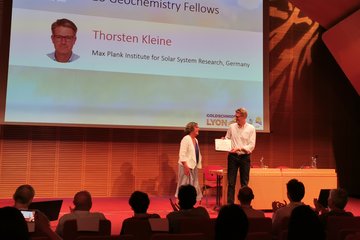Alle Typen
1.
Zeitschriftenartikel
Comment on "Long-term Variations of Venus's 365 nm Albedo Observed by Venus Express, Akatsuki, MESSENGER, and the Hubble SpaceTelescope" by Lee et al. (2019, AJ, 158, 126). Research notes of the AAS 3 (11), 168 (2020)
2.
Zeitschriftenartikel
Venus crater-related radar-dark parabolas and neighboring terrains: A comparison of 1-μm emissivity and microwave properties. Icarus 330, S. 103 - 122 (2019)
3.
Zeitschriftenartikel
Active Volcanism on Venus in the Ganiki Chasma Rift Zone. Geophysical Research Letters 42, S. 4762 - 4769 (2015)
4.
Zeitschriftenartikel
Optical properties of the Venus upper clouds from the data obtained by Venus Monitoring Camera on-board the Venus Express. Planetary and Space Science 113, S. 135 - 158 (2015)
5.
Zeitschriftenartikel
Retrieving lunar topography from multispectral LROC images. Planetary and Space Science 92, S. 65 - 76 (2014)
6.
Zeitschriftenartikel
Geologic interpretation of the near-infrared images of the surface taken by the Venus Monitoring Camera, Venus Express. Icarus 217 (2), S. 434 - 450 (2012)
7.
Zeitschriftenartikel
Search for ongoing volcanic activity on Venus: Case study of Maat Mons, Sapas Mons and Ozza Mons volcanoes. Planetary and Space Science 73, S. 294 - 301 (2012)
8.
Konferenzbeitrag
Microwave Properties and the 1-Micron Emissivity of Crater-Related Radar-Dark Parabolas and Other Surface Features in Five Areas of Venus. In: LPSC LPI Contribution No. 1832, S. 1135 - 1136. (2015)
9.
Vortrag
Volcanism of Venus: Insights from the VMC data analysis. 40th COSPAR Scientific Assembly, Moscow, Russia (2014)
10.
Poster
Microwave Properties and the 1-Micron Emissivity of Crater-Related Radar-Dark Parabolas and Other Surface Features in Five Areas of Venus. 46th Lunar and Planetary Science Conference, The Woodlands, Texas, USA (2015)
11.
Hochschulschrift - Doktorarbeit
Study of the Venus surface and lower atmosphere using VMC images. Dissertation, Technische Universität Braunschweig (2013)











